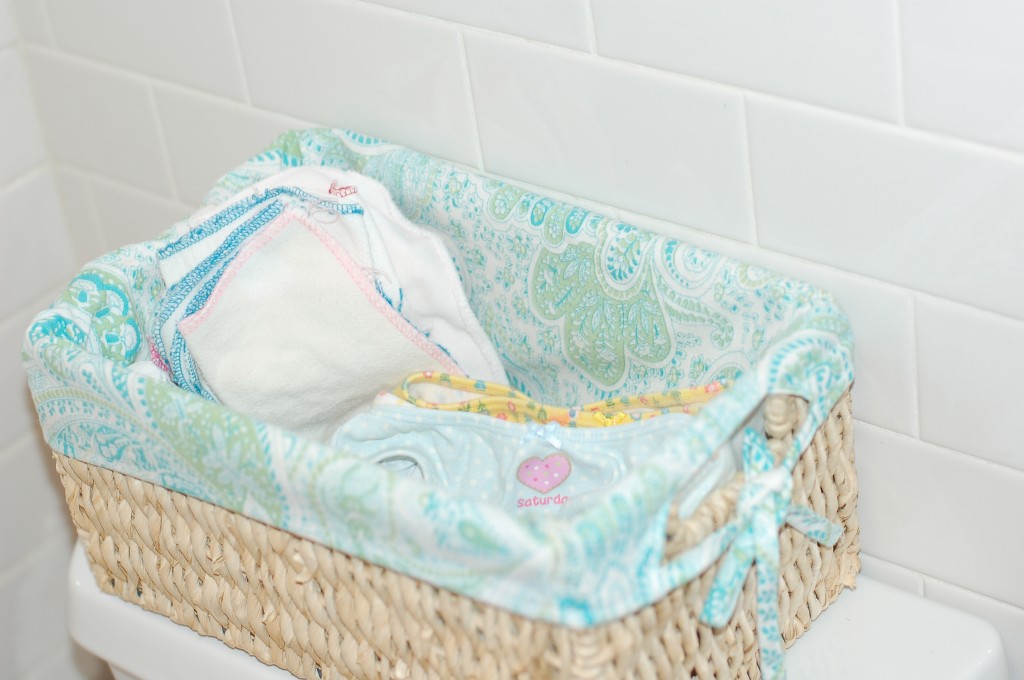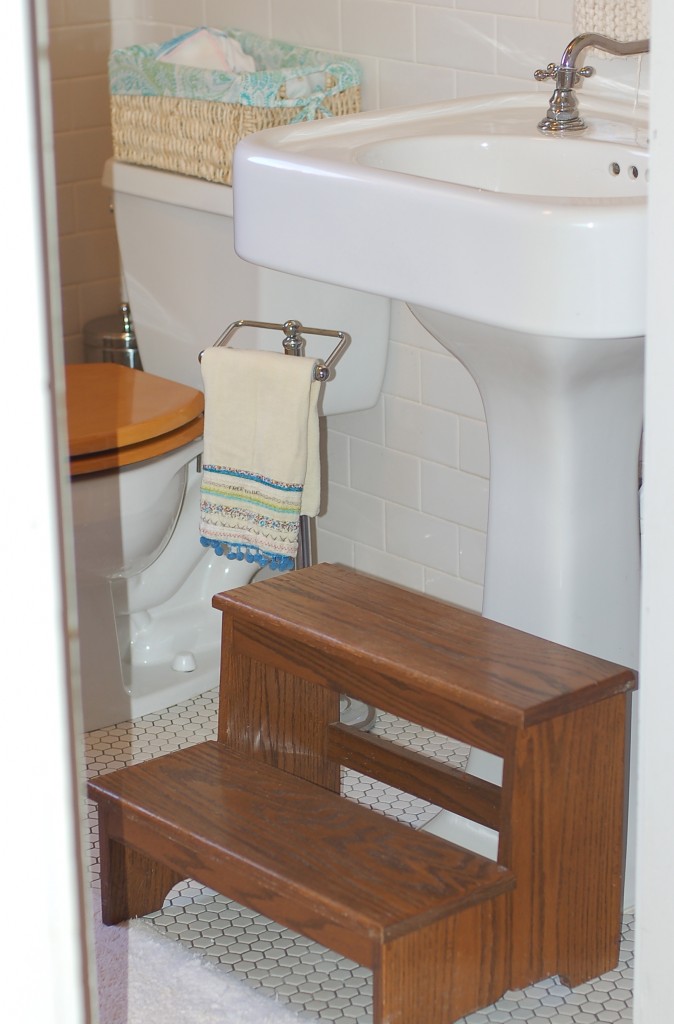This week my third child hit that milestone. Not only did she decide to stop wearing diapers, she won’t wear training pants either, or any kind of thick styled absorbent underwear (which I am more in favor of when accidents happen). As a mom of three I know how fast children grow. Wanting to keep my baby a baby as long as I can, I didn’t push the potty training thing this time around.
But when she discovered the polka dot panties I recently slipped into a bin alongside the baskets of cloth diapers, she loved them enough to now insist on those being the only thing she’ll wear.
Next month she’ll be two-and-a-half years old. So, I guess it was time.
It was about that age for all my daughters when potty training led to full on underwear mode. But it was something different that triggered it for all of them.
My first girl started pooping in the big potty at 18 months old because having that in her diaper truly grossed her out. We were on a road trip in Colorado, driving through the mountains when she had a bizarre screaming, panic fit in her car seat. We pulled over and I took her into a public bathroom. She went on the toilet and never pooped in a diaper again.
Fully saying goodbye to diapers didn’t click until she was about 27 months, after her baby sister was born and she saw that diapers were for babies. She wanted to be a big girl.
My middle girl was the opposite. She’s a silly head. She would take off her diaper, pee on the floor, all over herself, and think it was hilarious. When we acquired a vintage wooden potty seat with a built in place for books and her own toilet paper roll – she loved going into the bathroom, closing the door and asking for “privacy.” That was her turning point.
I think kids have to be ready to use the toilet, and be developing a natural sense of independence where they want to dress themselves, learn the right way to put on underwear (for us that means the bow goes in the front) and go through the motions of taking care of themselves. This leads to the Montessori part.
When children are given the tools and environment that easily allows them to take ownership of their actions – to have their clothes and underwear accessible to them, a potty that is their size and a stool to help them wash their hands – it eventually becomes something they want to do for themselves.
Montessori experts say the earlier you start, and make it part of your child’s routine, the easier toilet training will be. The older they get, the more apt they are to protest it.
For instance, the owner of my toddler’s Montessori school has an eight month old who uses a small potty. She obviously can’t communicate that she needs to use it. So in my opinion this is more elimination communication – which is a lot effort on the parent’s part. Nonetheless, she has potty and after her daily nap it’s part of her routine to sit on it. And she is having some success at it.
Obviously, the more kids you have the harder it is to devote this kind of time to one child. And this mom lives/works with her child at the Montessori school.
For each of our girls, we started introducing a potty seat at about 18 months old. At first they would explore it, play with it, and eventually sit on it – modeling after other family members in the bathroom. They have also been in pre-school environments where they have seen other toddlers using a child-size toilet.
In August, before my toddler turned two, she started attending a Montessori school three mornings a week. The program is for walking age babies/toddlers to age three. She was the first of my children to start a Montessori program that young. I found the toilet training habits there to be interesting.
The school uses no diapers. They require the toddlers to wear cloth-training underwear. In class all the students wear no pants, just underwear and a shirt or dress. This allows even the 15-month-old children to easily take off and on their own underwear. When they nap or go outside to play, they wear a waterproof cover over the cloth-training underwear.
When the students arrive, they all sit on the potty. Before snack, they all sit on the potty. Before nap and early dismissal, they all sit on the potty. Much of the day revolves around toilet training and the practical life side of caring for one’s self.
Having this schedule and this introduction to toilet training, I’m sure if I would have been more diligent about carrying this routine over at home, my toddler would have been in this full-on panty wearing place sooner. But having the hectic lives we do, with a large family, schedules outside our home and other school pick up times in our day – having our daily routine at home revolve around a potty schedule was not feasible.
So I took faith that it will happen when it happens, when the time is right for her. And honestly, the way this third girl of mine could have cared less if she wore the same wet diaper all day long – I thought she was going to be really hard to potty train. But I was wrong.
As soon as I regoranized her closet, her diaper baskets and created that basket of panties for her – that was all it took. She really was ready to do it by herself. This week she made the choose to do it. I had little to do with it.
Below are some photos and tips from our set up at home, that helped instill the independence for my toddler to want to use the potty.
One is to have clothes that your child can easily put on and off herself. That means pants with no buttons or garments with hard to reach zippers. Have clothing organized and set up low enough for children to reach themselves, in the morning and for when they do have accidents. This adds to the enjoyment of doing things for themselves at this age.
Two is to have a potty they can get on and off themselves. Along with toilet paper they can access.
Three is to have things handy for accidents in the bathroom. We keep a basket of cloth wipes and extra underwear to clean up accidents in the bathroom. There is also a dirty clothes hamper in the hallway that is used for soiled clothing, which was previously used for cloth diapers.
Four is to make hand washing easily accessible. Keep a stool near the sink tall enough for them to reach the soap and turn the water on. Bars of soap are easier for them to use than the hand pumps. Cutting soup into smaller sizes for smaller hands is nice. Have hand towels where they can reach. Our bathroom is all tile. So I turned a self-standing toilet paper holder into a a towel bar holder, with a basket of extra towels nearby so the children can replace them when needed.
Five is to make it fun! Put books in the bathroom and make up fun songs. For all three kids I’ve been singing, to the tune of Twinkle, Twinkle Little Star – Tinkle tinkle little pee pee, potty potty here it comes. Then we listen. And sing it again. And clap and praise when it happens.




What a beautiful little setup you have, showing love and care and respect. Thanks for the gorgeous photos:)
Thanks for sharing! I always find it interesting to see how others “do it”. We attempted to train at 18 months with our first son and found it to be a lot of work – like your comment about elimination communication. Our son was ready at about 2 3/4 years and then it took very little effort on our part. We just opted for underwear during the day and pull-ups at night. We never used a potty or a toddler seat for the toilet. He just used the stool and sat toward the front of the regular toilet. Yes he had a couple splashes – but we were always there with him in the beginning and it was only ever a couple of times since he learned fairly quick he had to stable himself. I wonder how those who use a potty transition to the toilet and whether it is a second training of sorts. Same with the book idea. Do your girls still read in the bathroom?
Kristy – transitioning to the big toilet was never a problem for us. She uses one when we are in public, I just have to help her. One day when they get tall enough they just start doing it at home too. But for now, having a small one gives her more independence. With a small potty, and this set up, she can potty all by herself and take full ownership of the whole process. No my girls don’t read in the bathroom anymore. I think it’s just something to help in the beginning, to add to the fun and time spent sitting on the potty discovering how it all works. I’m glad you found this post helpful!
Thea, I’m glad you enjoyed the photos. And thanks for you comment.
Thanks for the additional remarks 🙂
I loved to read about your toileting journey. Your potty is gorgeous and I couldn’t think of a more complete set up.
Beautiful set-up and great tips! We are about to start potty training my son and I’m a little nervous. I hear that boys are more challenging than girls. My daughter was a breeze!
This is a great article! I’m about to start the potty learning process with my son and I will be referencing this!!